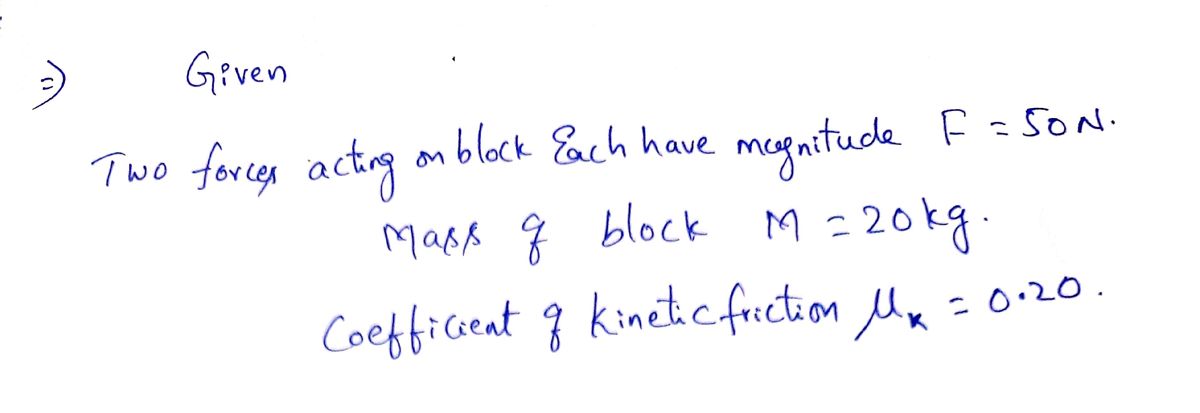A block slides on a surface when two forces act on it as shown in the figure. The two forces acting on it each have magnitude F = 50.0 N and M = 20.0 kg, and coefficient of kinetic friction is 0.20. a. Find the net force in the vertical direction b. Find the net force in the horizontal direction c. What is the magnitude of the resulting acceleration of the block? 30°
A block slides on a surface when two forces act on it as shown in the figure. The two forces acting on it each have magnitude F = 50.0 N and M = 20.0 kg, and coefficient of kinetic friction is 0.20. a. Find the net force in the vertical direction b. Find the net force in the horizontal direction c. What is the magnitude of the resulting acceleration of the block? 30°
College Physics
11th Edition
ISBN:9781305952300
Author:Raymond A. Serway, Chris Vuille
Publisher:Raymond A. Serway, Chris Vuille
Chapter1: Units, Trigonometry. And Vectors
Section: Chapter Questions
Problem 1CQ: Estimate the order of magnitude of the length, in meters, of each of the following; (a) a mouse, (b)...
Related questions
Topic Video
Question

Transcribed Image Text:### Problem Description
A block slides on a surface when two forces act on it as shown in the figure. The two forces acting on it each have a magnitude of \( F = 50.0 \, \text{N} \) and the mass of the block \( M = 20.0 \, \text{kg} \). The coefficient of kinetic friction is 0.20.
#### Questions:
a. Find the net force in the vertical direction.
b. Find the net force in the horizontal direction.
c. What is the magnitude of the resulting acceleration of the block?
### Diagram Explanation
The diagram shows a block with mass \( M \) positioned on a horizontal surface. Two forces of equal magnitude \( F \) are acting on the block. One force is directed at an angle of \( 30^\circ \) to the horizontal surface on the left side of the block. The other force is directed horizontally towards the right side of the block.
The force acting at an angle can be decomposed into two components: one vertical and one horizontal. The coefficient of kinetic friction between the block and surface is used to calculate the frictional force.
### Analysis
- **Vertical Direction:** Analyze the vertical components of the forces acting on the block due to gravity and the vertical component of \( F \).
- **Horizontal Direction:** Consider the horizontal components of the forces and the opposing frictional force.
- **Acceleration Calculation:** Use Newton’s second law to find the block's acceleration.
### Key Formulas
- **Decomposition of Forces:**
- \( F_{\text{horizontal}} = F \cos(30^\circ) \)
- \( F_{\text{vertical}} = F \sin(30^\circ) \)
- **Frictional Force:**
- \( f_k = \mu_k N \)
- **Newton’s Second Law:**
- \( F_{\text{net}} = ma \)
This problem involves applying principles of physics related to force decomposition, friction, and motion on a horizontal plane.
Expert Solution
Step 1

Step by step
Solved in 2 steps with 2 images

Knowledge Booster
Learn more about
Need a deep-dive on the concept behind this application? Look no further. Learn more about this topic, physics and related others by exploring similar questions and additional content below.Recommended textbooks for you

College Physics
Physics
ISBN:
9781305952300
Author:
Raymond A. Serway, Chris Vuille
Publisher:
Cengage Learning

University Physics (14th Edition)
Physics
ISBN:
9780133969290
Author:
Hugh D. Young, Roger A. Freedman
Publisher:
PEARSON

Introduction To Quantum Mechanics
Physics
ISBN:
9781107189638
Author:
Griffiths, David J., Schroeter, Darrell F.
Publisher:
Cambridge University Press

College Physics
Physics
ISBN:
9781305952300
Author:
Raymond A. Serway, Chris Vuille
Publisher:
Cengage Learning

University Physics (14th Edition)
Physics
ISBN:
9780133969290
Author:
Hugh D. Young, Roger A. Freedman
Publisher:
PEARSON

Introduction To Quantum Mechanics
Physics
ISBN:
9781107189638
Author:
Griffiths, David J., Schroeter, Darrell F.
Publisher:
Cambridge University Press

Physics for Scientists and Engineers
Physics
ISBN:
9781337553278
Author:
Raymond A. Serway, John W. Jewett
Publisher:
Cengage Learning

Lecture- Tutorials for Introductory Astronomy
Physics
ISBN:
9780321820464
Author:
Edward E. Prather, Tim P. Slater, Jeff P. Adams, Gina Brissenden
Publisher:
Addison-Wesley

College Physics: A Strategic Approach (4th Editio…
Physics
ISBN:
9780134609034
Author:
Randall D. Knight (Professor Emeritus), Brian Jones, Stuart Field
Publisher:
PEARSON